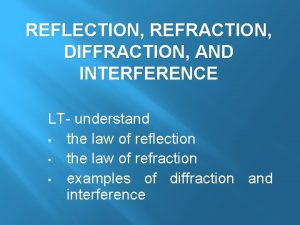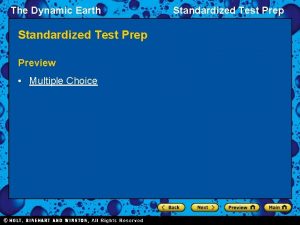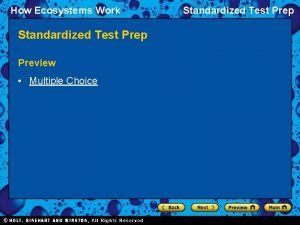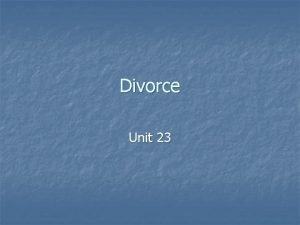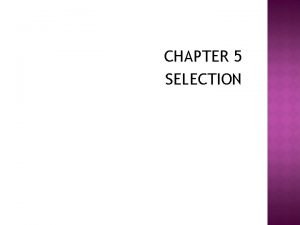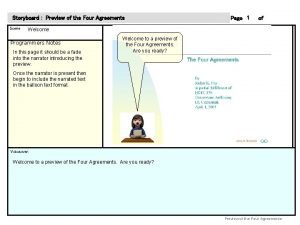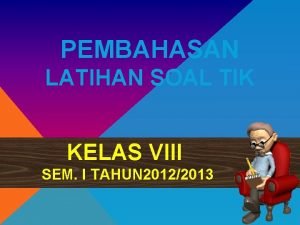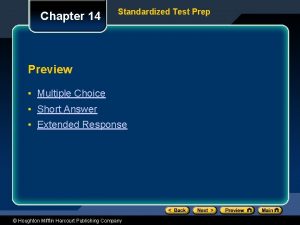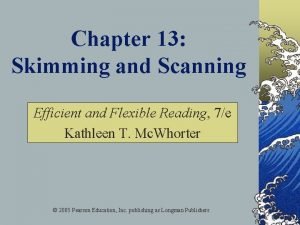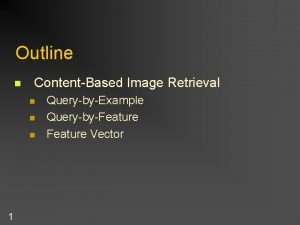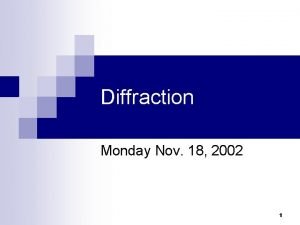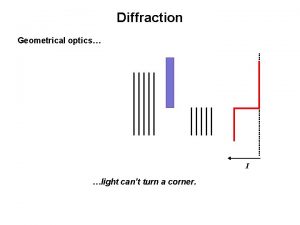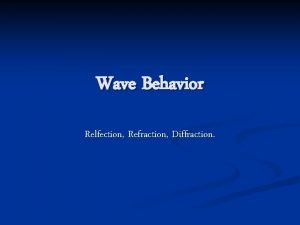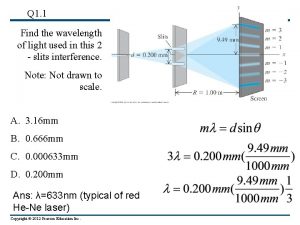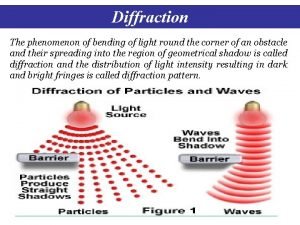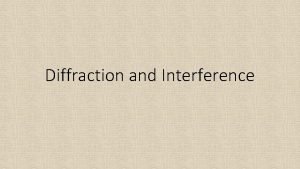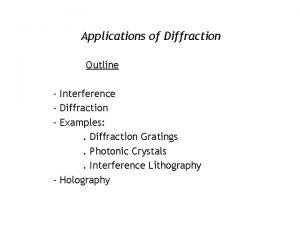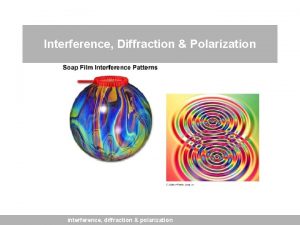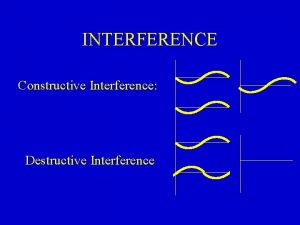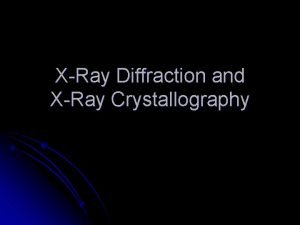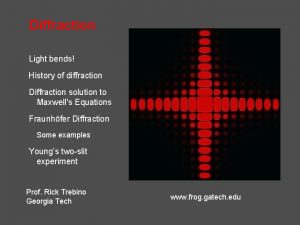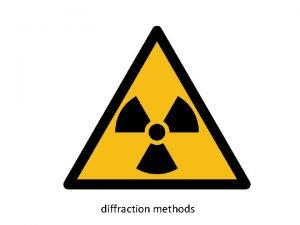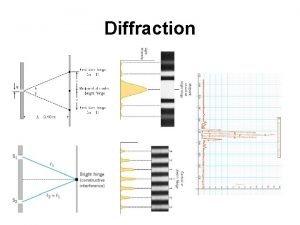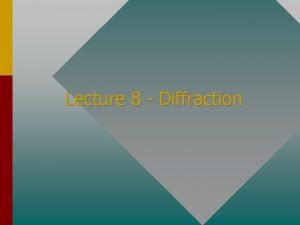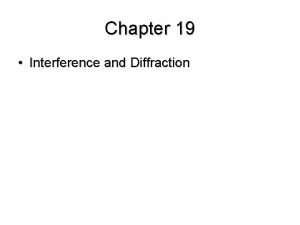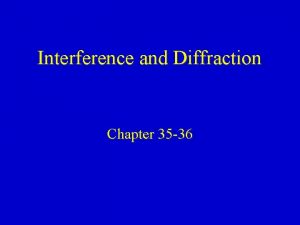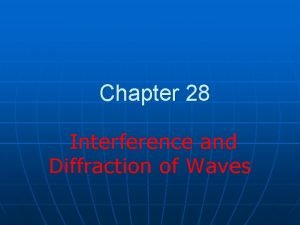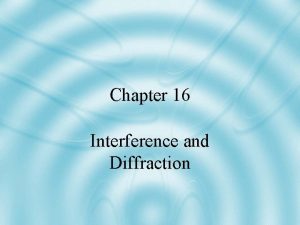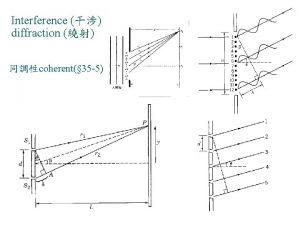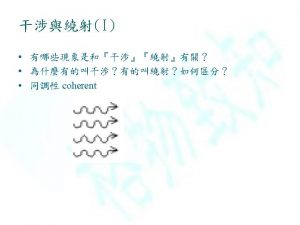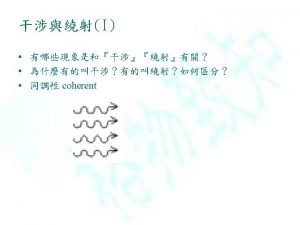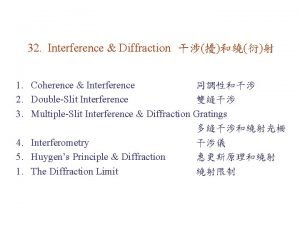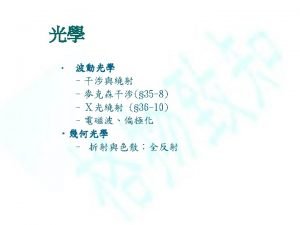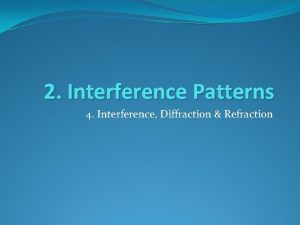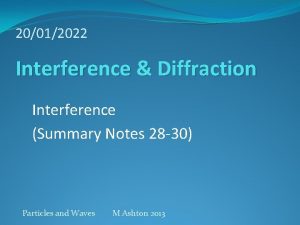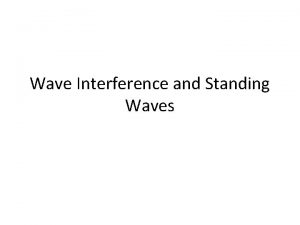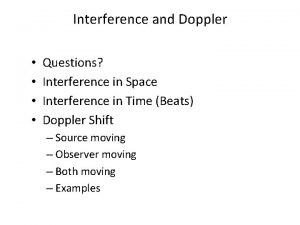Interference and Diffraction Preview Section 1 Interference Section







































- Slides: 39

Interference and Diffraction Preview Section 1 Interference Section 2 Diffraction Section 3 Lasers © Houghton Mifflin Harcourt Publishing Company Section 1

Interference and Diffraction Section 1 What do you think? • Sound waves and water waves can interfere constructively and destructively. Examples are the wake behind a boat, beats used to tune instruments, and dead spots in auditoriums. Can light waves interfere as well? • If so, can you think of any examples? • Suppose two light waves were to interfere destructively and cancel, so no light was seen. How might this occur? © Houghton Mifflin Harcourt Publishing Company

Interference and Diffraction Section 1 Light Wave Interference • Like other waves, light waves can add constructively and destructively as shown above. • Examples: – Colors seen in soap bubbles – Colors seen in a thin film of oil on water © Houghton Mifflin Harcourt Publishing Company

Interference and Diffraction Section 1 Requirement for Interference • Waves must maintain a constant phase relationship, or be coherent. – In figure a, the waves are in phase. – In figure b, the waves are out of phase. • Incoherent light has phase relationships that shift. – Interference will not be observed. © Houghton Mifflin Harcourt Publishing Company

Interference and Diffraction Section 1 Comparing Noncoherent and Coherent Light Click below to watch the Visual Concept © Houghton Mifflin Harcourt Publishing Company

Interference and Diffraction Section 1 Demonstrating Interference • Light from a single source passes through two slits, creating two coherent sources. • The two waves then spread out in all directions (Huygen’s Principle) and interfere with each other. – Constructive interference creates bright spots on a screen. – Destructive interference creates dark spots on a screen. © Houghton Mifflin Harcourt Publishing Company

Interference and Diffraction Section 1 Constructive Interference • The two waves travel the same distance to the center of the screen. – They arrive in phase. – Constructive interference occurs. – A bright spot is seen in the middle of the screen. © Houghton Mifflin Harcourt Publishing Company

Interference and Diffraction Section 1 Constructive Interference • The top wave travels a distance of 1 farther than the bottom wave. – They arrive at the screen in phase. – Constructive interference occurs. – A bright spot is seen. • What distances other than 1 would result in a bright spot on the screen? © Houghton Mifflin Harcourt Publishing Company

Interference and Diffraction Section 1 Destructive Interference • The top wave travels a distance of (1/2) farther than the bottom wave. – They arrive at the screen out of phase. – Destructive interference occurs. – A dark area is seen. • What distances other than (1/2) would result in a dark area on the screen? © Houghton Mifflin Harcourt Publishing Company

Interference and Diffraction Interference Arising from Two Slits Click below to watch the Visual Concept © Houghton Mifflin Harcourt Publishing Company Section 1

Interference and Diffraction Section 1 Calculating Maxima and Minima • Because the screen is distant, l 1 and l 2 are nearly parallel. • This makes the angles almost equal. – d sin is the extra distance the lower wave travels while moving to a common point on the screen. © Houghton Mifflin Harcourt Publishing Company

Interference and Diffraction Section 1 Calculating Maxima and Minima • For constructive interference, d sin (path length difference) is a whole number of wavelengths. • For destructive interference, the path length difference is an odd number of half-wavelengths (1/2, 3/2, 5/2 and so on). © Houghton Mifflin Harcourt Publishing Company

Interference and Diffraction Section 1 Classroom Practice Problem • The distance between the two slits is 0. 0050 mm. Find the angles of the zeroth-, first-, second- and thirdorder bright fringes of interference produced by light with a wavelength of 550 nm. – Answers: 0°, 6. 3°, 19° © Houghton Mifflin Harcourt Publishing Company

Interference and Diffraction Section 1 Classroom Practice Problem • When monochromatic light (light of a single wavelength) falls on two slits with a separation of 0. 010 mm, the zeroth-order dark fringes are observed at a 2. 0° angle. Find the wavelength. – Answer: 0. 00070 mm or 7. 0 10 -7 m or 7. 0 102 nm © Houghton Mifflin Harcourt Publishing Company

Interference and Diffraction Section 1 Now what do you think? • Sound waves and water waves can interfere constructively and destructively. Examples are the wake behind a boat, beats used to tune instruments and dead spots in auditoriums. Can light waves interfere as well? • If so, can you think of any examples? • Suppose two light waves were to interfere destructively and cancel, so no light was seen. How might this occur? © Houghton Mifflin Harcourt Publishing Company

Interference and Diffraction Section 2 What do you think? • Suppose you are standing off to the side of a door on your friend’s porch. She is inside the house speaking to you. Can you hear her, even though you are off to the side of the door? • Using your knowledge of waves, explain how this might occur. • Consider the same situation described above. Can you see your friend when standing off to the side of the door? • Why or why not? © Houghton Mifflin Harcourt Publishing Company

Interference and Diffraction Section 2 Diffraction • A change in direction for waves when they encounter an obstacle or pass through an opening – Sound waves around a tree or through a door – Huygens’ principle states each point on a wave is a source for new waves. • Diffraction occurs to a greater extent if the wavelength and opening size are appropriate. – Openings much larger than the wavelength show very little diffraction. • Light waves through a door © Houghton Mifflin Harcourt Publishing Company

Interference and Diffraction Single Slit Interference • Occurs because one part of the wave interferes with the other parts • The diagram shows 5 sample points, each producing waves. – The center line will be a point of constructive interference. – Waves 1 and 5 travel the same distance to this line as do waves 2 and 4. © Houghton Mifflin Harcourt Publishing Company Section 2

Interference and Diffraction Section 2 Single Slit Interference • In order to reach a point above the center line, waves travel different distances. – Wave 3 travels 1/2 farther than wave 1, so destructive interference occurs. – Similarly, wave 5 travels 1/2 farther than wave 3. • Thus, at the angle shown, destructive interference occurs and the screen is dark. © Houghton Mifflin Harcourt Publishing Company

Interference and Diffraction Section 2 Diffraction Around Obstacles • Suppose a laser shines on a screen. The round head of a pin (like those used to pin clothing) is placed between the laser and screen. You would expect to see a round shadow on the screen. – What will you see in the center of the shadow? Why? – You will see a bright spot if you look very carefully. The waves diffract and all waves travel the same distance to the center of the shadow, creating constructive interference. © Houghton Mifflin Harcourt Publishing Company

Interference and Diffraction Section 2 Diffraction Gratings • Many slits very closely spaced – Behaves like the double slit, but maxima and minima are much brighter. • Monochromatic light produces bright and dark fringes. • White light produces a full spectrum. – Similar to reflection off a CD surface © Houghton Mifflin Harcourt Publishing Company

Interference and Diffraction Section 2 Diffraction Gratings • Diffraction gratings are used in spectrometers to separate light into its component colors. – Used to study the makeup of distant stars – Helium’s spectrum was first observed on the sun, and helium was later discovered on Earth. © Houghton Mifflin Harcourt Publishing Company

Interference and Diffraction Function of a Spectrometer Click below to watch the Visual Concept © Houghton Mifflin Harcourt Publishing Company Section 2

Interference and Diffraction Section 2 Problem Solving - Diffraction Gratings • Equations are identical to those for two slit interference. – d is the distance between adjacent slits or lines. – If there are 8000 lines per cm, then d = (1/8000) cm © Houghton Mifflin Harcourt Publishing Company

Interference and Diffraction Section 2 Classroom Practice Problems • Monochromatic light shines on the surface of a diffraction grating with 5. 0 103 lines/cm. The first order maximum is observed at an angle of 15°. Find the wavelength. – Answer: 5. 2 102 nm • Find the first-order and the second-order angles of diffraction observed through a 1. 0 104 lines/cm diffraction grating with light of wavelengths 400. 0 nm and 600. 0 nm – Answers for 400 nm light: 23. 6°; 53. 1° – Answers for 600. 0 nm light: 36. 9°; the second order does not occur because it would be greater than 90° (sin = 1. 2 does not occur) © Houghton Mifflin Harcourt Publishing Company

Interference and Diffraction Section 2 Instrument Resolution • If observing two distant objects, the diffraction patterns could overlap as shown. • Without diffraction, there would be two bright spots on the screen. © Houghton Mifflin Harcourt Publishing Company

Interference and Diffraction Section 2 Resolving Power • The wavelength ( ) and the opening size (D) determine the resolving power. – is the limiting angle between the two resolved objects measured in radians. – Longer wavelengths require a larger aperture (D) to resolve distant objects. – Because radio waves are long waves, radio telescopes are very large to accommodate the need for a large aperture. © Houghton Mifflin Harcourt Publishing Company

Interference and Diffraction Section 2 Instrument Resolution • Imagine the opening is the pupil of your eye and the two sources are adjacent red and green pixels on your television screen. – What will you see? – How would it change if your pupil opening was larger? – How would it change if you were closer? – How would it change if the pixels were farther apart? © Houghton Mifflin Harcourt Publishing Company

Interference and Diffraction Section 2 Now what do you think? • Suppose you are standing off to the side of a door on your friend’s porch. She is inside the house speaking to you. Can you hear her, even though you are off to the side of the door? – Using your knowledge of waves, explain how this might occur. • Consider the same situation described above. Can you see your friend when standing off to the side of the door? – Why or why not? © Houghton Mifflin Harcourt Publishing Company

Interference and Diffraction Section 3 What do you think? • Lasers are quite common in today’s world. List all applications for lasers that come to mind. • How does the use of a laser in each application improve on prior methods? • For example, a laser pointer can be used from anywhere in the room. • How is laser light different from other forms of light, such as that produced by a flashlight? • Is it produced differently? Explain. • Does it behave differently? Explain. © Houghton Mifflin Harcourt Publishing Company

Interference and Diffraction Section 3 Coherent Light • Light bulb filaments emit light of many different wavelengths and phases. – Hot filaments emit incoherent light. – Like water waves on a pond during the rain • Lasers produce a narrow beam of coherent light. – Laser light is not produced by a hot filament. © Houghton Mifflin Harcourt Publishing Company

Interference and Diffraction Section 3 Laser • LASER is an acronym. – Light Amplification by Stimulated Emission of Radiation • Lasers use light, electrical energy, or chemical energy to produce coherent light. • The active medium can be a solid, liquid, or gas. – The medium determines the wavelength of the light. © Houghton Mifflin Harcourt Publishing Company

Interference and Diffraction Section 3 Producing Light with a Laser (Step 1) • Energy is added to the medium. – When absorbing the energy, atoms move into higher energy states. – Excited atoms release this energy as light or some other EM radiation when they return to lower energy states. © Houghton Mifflin Harcourt Publishing Company

Interference and Diffraction Section 3 Producing Light with a Laser (Step 2) • Light emitted by one atom can induce adjacent atoms to emit light with the same properties (wavelength and phase). – The process continues, and light intensity begins to increase. – Called stimulated emission © Houghton Mifflin Harcourt Publishing Company

Interference and Diffraction Section 3 Producing Light with a Laser (Step 3) • Mirrors at the ends reflect the light back into the medium, and intensity continues to increase. • The mirror on the right is not fully reflective. Thus, some light passes through once the intensity is great enough. • The light is monochromatic and in phase (coherent). © Houghton Mifflin Harcourt Publishing Company

Interference and Diffraction Laser Click below to watch the Visual Concept © Houghton Mifflin Harcourt Publishing Company Section 3

Interference and Diffraction Section 3 Applications of Lasers • Measuring distance is possible because the beam does not spread out very much. – Mirrors left on the moon are used to reflect laser light back to Earth to determine the distance. • Accurate to within a few centimeters • Able to measure the rise and fall of Earth’s crust © Houghton Mifflin Harcourt Publishing Company

Interference and Diffraction Section 3 Applications of Lasers • Medical uses – Certain lasers that pass though the cornea and lens can be used to treat tears in the retina or to seal bleeding vessels in the retina. – Lasers can be used for incisions. • This cauterizes the wound while cutting to reduce bleeding. – Laser light can pass through optical fibers and treat internal problems without massive surgery. © Houghton Mifflin Harcourt Publishing Company

Interference and Diffraction Section 3 Now what do you think? • Lasers are quite common in today’s world. List all applications for lasers that come to mind. – How does the use of a laser in each application improve on prior methods? • For example, a laser pointer can be used from anywhere in the room. – How is laser light different from other forms of light, such as that produced by a flashlight? • Is it produced differently? Explain. • Does it behave differently? Explain. © Houghton Mifflin Harcourt Publishing Company
 Diffraction pattern
Diffraction pattern Reflection refraction diffraction interference
Reflection refraction diffraction interference Example of retroactive interference
Example of retroactive interference Retrospective interference
Retrospective interference Thesis essay
Thesis essay Thesis statement summary
Thesis statement summary What is a preview statement
What is a preview statement Realistic job preview advantages and disadvantages
Realistic job preview advantages and disadvantages Review and preview
Review and preview Benefits of hr forecasting
Benefits of hr forecasting Test prep preview
Test prep preview Test prep preview
Test prep preview Test prep preview
Test prep preview Test prep preview
Test prep preview Sccm technical preview
Sccm technical preview Preview statement speech example
Preview statement speech example Test prep preview
Test prep preview Nnn preview
Nnn preview The selection preview
The selection preview Test prep preview
Test prep preview The four agreements preview
The four agreements preview Test prep preview
Test prep preview Perintah print preview kita jalankan dari menu
Perintah print preview kita jalankan dari menu Test prep preview
Test prep preview What is overview skimming
What is overview skimming 1984 book preview
1984 book preview Yandex ru film
Yandex ru film Nút lệnh print preview nằm ở đâu
Nút lệnh print preview nằm ở đâu Tams ut austin
Tams ut austin Disadvantages of realistic job preview
Disadvantages of realistic job preview Preview of main points
Preview of main points Preview speech
Preview speech Paraverbal communication definition
Paraverbal communication definition Nnn image preview
Nnn image preview Menu collections pane di windows movie maker berguna untuk
Menu collections pane di windows movie maker berguna untuk Fraunhofer and fresnel diffraction
Fraunhofer and fresnel diffraction Fresnel lens vs convex lens
Fresnel lens vs convex lens Blue relfection ray
Blue relfection ray Fresnel and fraunhofer diffraction difference
Fresnel and fraunhofer diffraction difference Missing order in diffraction
Missing order in diffraction

